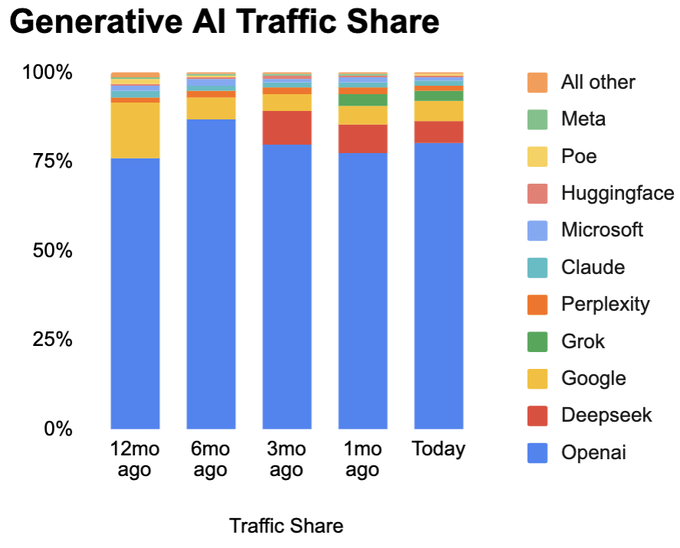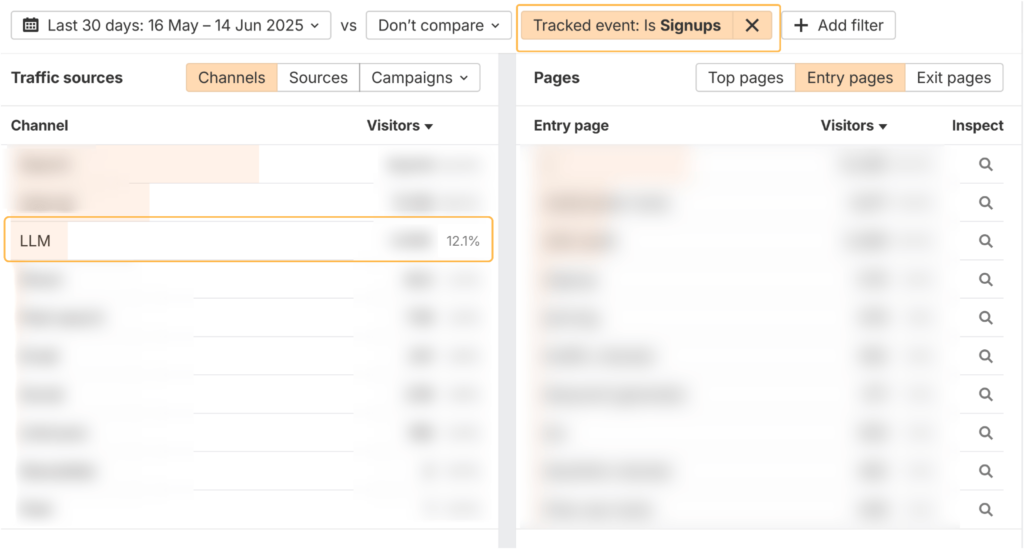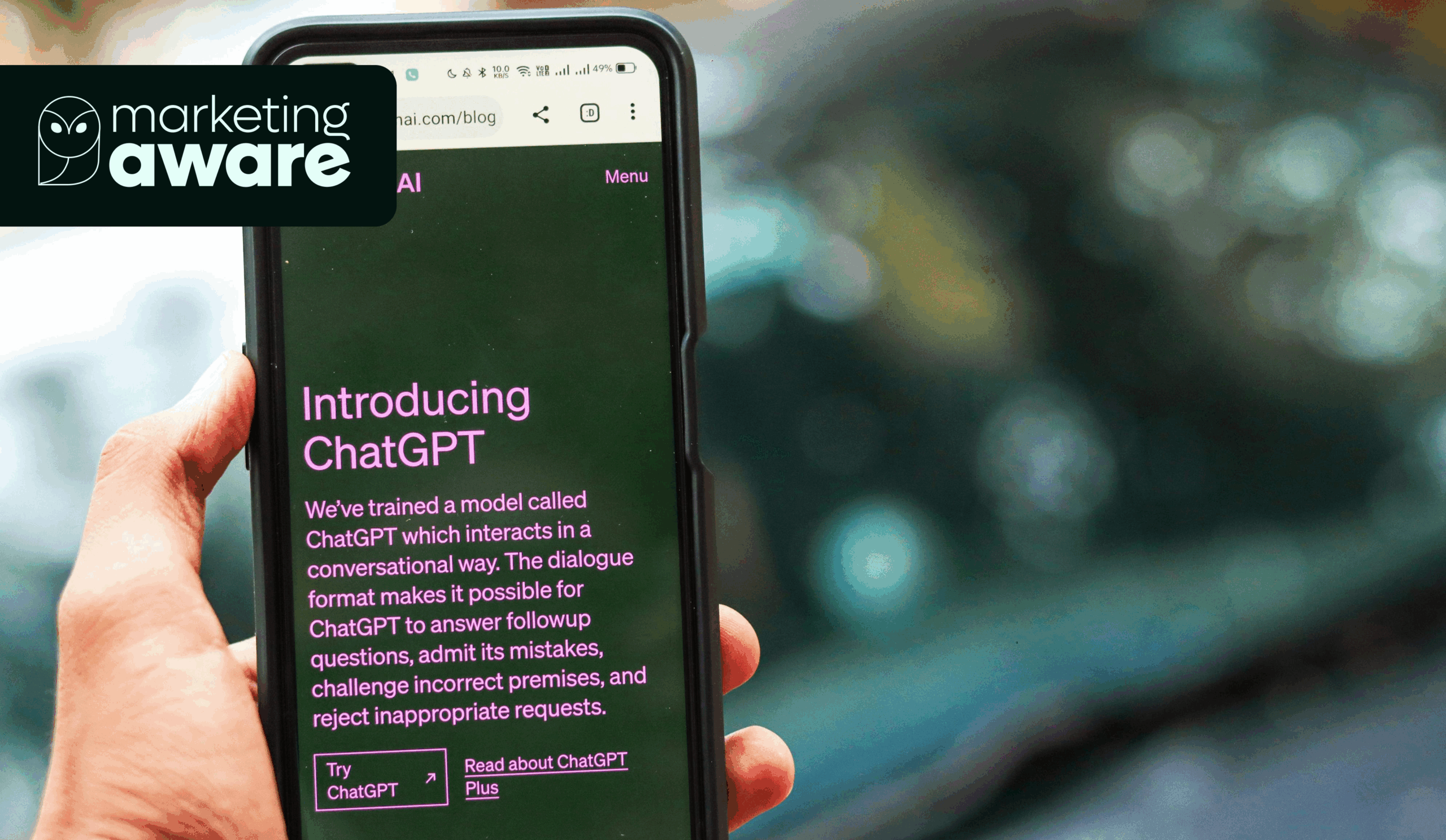Understanding AI Search Behavior
One of the most common questions we get in SEO strategy sessions is: “How do I get my business cited in ChatGPT for relevant queries?” While this applies to other AI engines as well, OpenAI currently dominates the AI search landscape—with 77.6% market share according to Similarweb (May 2025). Competitors like Google’s AI mode (5.5%) and Grok are quickly gaining ground, but ChatGPT remains the frontrunner.

Across our clients—including SaaS brands, B2B service providers, and local multi-location businesses—we’re now seeing an average of 1% of website traffic coming directly from ChatGPT. That number is only set to grow. I will caveat this and say referral traffic isn’t the utopian metric when it comes to assessing AI engine performance (but we will come to this later).
Looking at the quality of AI traffic, according to one of our SEO analytics partners AHREFS, 0.5% of their traffic comes from AI engines and a whopping 12.1% of overall sign ups come from AI search. Granted, AI engines are becoming an increasing part of SEOs workflow but this stat highlights the sheer quality of traffic arriving from AI engines.

Whilst AI engines arn’t the dominant force in search just yet the signs tell us they will be. But the real question is: just how big, and how do we position ourselves to benefit from this seismic shift in search behaviour?
This article breaks down the strategies we are using to help clients get found—inside ChatGPT and across the AI search ecosystem.
Understand the New AI Search Discovery Paradigm (Chat GPT)
Through my work on custom AI development projects at Sapien Data, I’ve had the opportunity to peek under the hood of how AI models operate. This provides the perspective of a double agent—someone who sees AI systems from the inside whilst also decoding how to influence them from the outside.
To address the common misconception first, ChatGPT’s web browsing tool doesn’t behave like Google Search. It’s not trying to build a search index or rank websites traditionally (anyone who tells you they will rank you in ChatGPT is missing this subtle difference). Instead it leverages its integration with Bing’s Search API, which allows the model to access fresh content from the web—similar to how a human might conduct a Google search (yes, you will have to dust the cobwebs of your Bing Webmaster Tools):
Google Search is a directory of links—AI engines are answer generators.
To win in Google, you rank. To win in AI, you get quoted.
SEO for AI search is less about visibility and more about authority and context.
What Does It Take to be Cited in AI Search?
Traditional SEO still matters: To appear in AI-generated answers (like ChatGPT), your content must first be trusted by traditional search engines. If your page doesn’t rank on Google, it’s unlikely to be surfaced or cited by AI tools.
Authority is everything: Language models are trained on high-quality, authoritative sources. This makes domain trust, SEO backlinks, and strong SEO fundamentals essential for inclusion in AI training and retrieval pipelines.
Structure and clarity boost AI visibility: Well-organised, semantically rich, and clearly written content is more likely to be extracted and cited accurately by generative models.
Citation replaces the click-through: Unlike Google, where users choose from a list of results, AI tools deliver direct answers. Getting cited by the model becomes the new form of visibility and brand exposure.
Referral traffic is still possible: Even in an AI-first environment, users may click on cited sources—especially when researching products, services, or complex topics. This makes citations a potential gateway to conversion.
So How To Tweak Your Strategy To Maximise Chat GPT Visibility?
1. Dust the cobwebs off Bing Webmaster tools
Bing webmaster tools have been sitting in the shadows of Google Search console for some time now. But with Chat GPTs integration with Bing’s index – it’s now a gaining a fresh lease of life and becoming a major player in the AI SEO landscape. Here is what to do:
- Install Bing Webmaster Tools
- Monitor top queries and impression trends (like you would in search console)
- Fine-tune your SEO strategy with Bings data in mind
2. Double Down on Topical Authority
- Repetition across multiple trustworthy sources
- Clear, simplified, fact-based language
- Sites that dominate a tightly defined niche
Don’t try to cover everything. Build a content moat around your niche by developing clusters of related content that reinforce your authority.
3. Build an Entity Web of Trust
AI models like ChatGPT tend to surface sources they “trust”—and that trust is built around strong, consistent entity signals across your site and the wider web. To boost your credibility in AI search, focus on:
- Clear entity signals (organisation, location, author, and subject matter expertise)
- Consistent mentions and citations across third-party sites
- Internal linking that reinforces topical depth and semantic connections
- Claim & optimise your knowledge panels (Google, Linkedin, Crunchbase)
- Encourage others to reference your content (especially trusted entities)
4. Optimise for Conversational & Intent-Driven Search
AI tools like ChatGPT favour content that mirrors how people naturally ask questions. To boost your visibility, structure your content with user intent in mind:
- Answer common queries using who, what, when, where, why, and how
- Use synonyms, related phrases, and semantic variations
- Write in a clear and conversational tone
5. Leverage Structured Content & Data
AI models prefer content that’s easy to scan, segment, and extract. To my earlier point, when we are building RAG AI models content structure is one of the biggest indicators for model accuracy. Structured content is easier to parse and reference. Here is what to do:
- FAQ sections with schema
- Comparison tables
- Step-by-step guides (HowTo markup)
6. Citations Signal Trust to AI
Being referenced by others builds credibility—and that matters for AI models trained on authoritative sources. To boost your content’s authority. Focus on:
- Earning citations from reputable domains (.edu, .gov, media)
- Encouraging backlinks to your guides, insights, and research
- Publishing original data, surveys, or industry benchmarks
These citations influence what LLMs ingest during training and surfacing content.
7. Publish Where the Models Are Listening
Large language models pull data from a wide range of public platforms—not just your website. Expanding your presence across these sources boosts your chances of being cited. Focus on:
- Participating in Reddit threads and Quora discussions
- Publishing on Medium and LinkedIn
- Contributing to GitHub (for technical content)
- Earning mentions in credible news outlets
Final Thoughts
AI search isn’t the future – it’s already here – quietly reshaping how people discover brands, ask questions, and make decisions. And while the hype around tools like ChatGPT is loud, the actual strategy required to show up in these environments is more grounded than most realise.
We’re still early in this shift. But those who take action now—dust off Bing, tighten up their topical clusters, claim their entity profiles—will be better positioned as AI continues to influence the way people search, learn, and buy.
The rules might be changing, but the goal is the same: be the most trusted voice in your space. AI just has a new way of listening.


